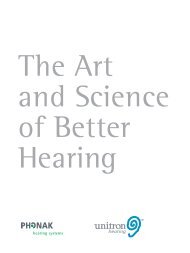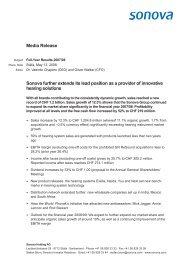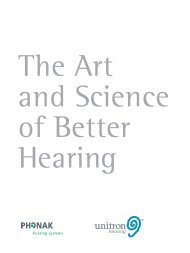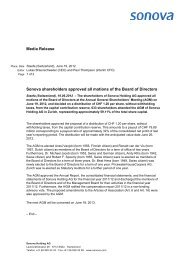ANNUAL REPORT 2008/09 - Sonova
ANNUAL REPORT 2008/09 - Sonova
ANNUAL REPORT 2008/09 - Sonova
You also want an ePaper? Increase the reach of your titles
YUMPU automatically turns print PDFs into web optimized ePapers that Google loves.
Expenses from defi ned benefi t plans are charged<br />
to the appropriate income statement heading within<br />
the operating results.<br />
Actuarial gains and losses, resulting from changes<br />
in actuarial assumptions and diff erences between<br />
assumptions and actual experiences are recognized<br />
in the period in which they occur in the statement<br />
of recognized income and expense in equity.<br />
Other long-term benefi ts<br />
Other long-term benefi ts mainly comprise length of<br />
service compensation benefi ts which certain Group<br />
Companies are required to provide in accordance<br />
with legal requirements in the respective countries.<br />
These benefi ts are accrued, and the corresponding<br />
liabilities are included under “Other provisions”.<br />
Equity compensation benefi ts<br />
The Board of Directors of <strong>Sonova</strong> Holding AG, the<br />
Management Board and certain management<br />
and senior employees of other Group Companies<br />
participate in equity compensation plans. The<br />
fair value of all equity compensation awards granted<br />
to employees is estimated, using an option pricing<br />
model, at the grant date and recorded as an expense<br />
over the vesting period. The expense is<br />
charged to the appropriate income statement heading<br />
within the operating result and an equivalent<br />
increase in equity is recorded.<br />
3.4 Financial assets<br />
<strong>Sonova</strong> classifi es its fi nancial assets in the following<br />
categories: fi nancial assets at fair value through<br />
profi t or loss, loans and receivables, held-to-maturity<br />
investments, and available-for-sale fi nancial assets.<br />
The classifi cation depends on the purpose for<br />
which the investments were acquired. Management<br />
determines the classifi cation of its investments<br />
at initial recognition and reclassifi es them whenever<br />
their intention or ability changes. All purchases<br />
and sales are recognized on the settlement date.<br />
72 CONSOLIDATED FINANCIAL STATEMENTS<br />
Financial assets at fair value through<br />
profi t or loss<br />
Financial assets at fair value through profi t or loss<br />
are assets held for trading, acquired for the purpose<br />
of generating a profi t from short-term fl uctuations<br />
in price. Derivative fi nancial assets and deriva<br />
tive fi nancial liabilities are always deemed as<br />
held for trading unless they are designated and eff ective<br />
hedging instruments. Financial assets held<br />
for trading are measured at their fair value plus initial<br />
transaction costs. Fair value changes on a fi nancial<br />
asset held for trading are included in net profi t or loss<br />
for the period in which they arise. Assets in this<br />
category are classifi ed as current assets if they are<br />
either held for trading or are expected to be realized<br />
within 12 months.<br />
Loans and receivables<br />
Loans and receivables are non-derivative fi nancial<br />
assets with fi xed or determinable payments that are<br />
not quoted in an active market. They arise when<br />
the Group provides money, goods or services directly<br />
to a debtor with no intention of trading the re -<br />
ceivable. They are included in current assets, except<br />
for maturities of more than 12 months. These are<br />
classifi ed as non-current assets. Loans and receivables<br />
are included in trade and other receivables in<br />
the balance sheet. Loans are measured at amortized<br />
cost. Amortized cost is the amount at which the<br />
fi nancial asset is measured at initial recognition mi -<br />
nus principal repayments, plus or minus the cumulative<br />
amorti zation using the eff ective interest method<br />
of any diff erence between the initial amount<br />
and the maturity amount, minus any reduction for<br />
impairment or uncollectibility. The eff ective in -<br />
terest method is a method calculating the amortized<br />
cost of a fi nancial asset and allocating the interest<br />
income over the relevant period. The eff ective interest<br />
rate is the rate that exactly discounts estimated<br />
future cash payments or receipts through the expected<br />
life of the fi nancial instrument or, when<br />
appropriate, a shorter period to the net carrying<br />
amount of the fi nancial asset.















